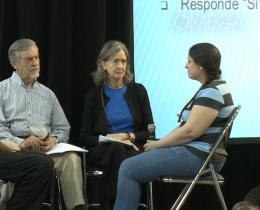In America we eat very quickly. Foreigners visiting early American taverns recorded their astonishment at how quickly food was eaten. The technique was dubbed “the three G’s” for “gobble, gulp, and go.”
Our propensity to eat and run has not diminished over the intervening two centuries. Research shows that North Americans spend only 11 minutes eating lunch at a fast-food restaurant and 18 minutes at a cafeteria in their workplace. Most children eat in less than nine minutes.
When we eat quickly we don’t chew our food thoroughly, missing out on flavor, nutrients, and textures. We also tend to feel less satisfied, missing the cues that tell us when our body has received all it needs.
Slowing down when eating is a great first step to eating more mindfully. Here are some ways to practice.
Make a Point of Pausing
- Pause before beginning your meal. Look at each item of food, taking it in with your eyes. Notice colors, textures, shapes, and arrangement on the plate or bowl.
- Take a moment to say grace. Thank the animals, plants, and people who brought this food to you. Be aware of their gifts as you eat.
- Begin your meal by pausing to inhale the fragrance of the food. Imagine that you are being nourished by just the smell.
- Eat like a wine connoisseur tastes wine. First sniff the food, enjoying the bouquet. Then take a small taste. Roll it around in your mouth, savoring it. What ingredients can you detect? Chew slowly and swallow. Take a sip of water to cleanse your palate. When the mouth is empty of food and flavor, repeat the process.
- If you notice that you are eating without tasting, stop and pause to look at the food again.
Fletcherize—Chew Your Food
The old name for a food blender was a Fletcherizer, after Horace Fletcher, who gave public talks in the early twentieth century about how he had lost weight and gained better health by chewing his food well. He recommended thirty-two chews for each bite. Start with trying to chew each bite of food at least fifteen times before swallowing, working your way up to around thirty.
Drink Slowly
Enjoy what you’re drinking by holding the liquid in your mouth for a few seconds before swallowing it. Swirl it around a bit and enjoy the taste. Pretend you’re in a television ad and show the audience how much you enjoy this drink. You can also put your cup or glass down while tasting and swallowing, picking it up again only when the mouth is empty and the taste is fading.
Put Down Your Utensils
This is one of the most reliable and simple ways to slow down your eating. Each time you put a bite of food into your mouth, put down the fork or spoon. Don’t pick it up again until the bite you have in your mouth is chewed and savored completely and swallowed.
Eat With Your Non-Dominant Hand
Deliberately eat using your non-dominant hand. If you usually eat with your right hand, use your left, and vice versa. Try this for one week and see what happens. It can be quite funny.
Eat With Chopsticks
This practice can make you more attentive to each bite. If you’re not very skilled with chopsticks, it can be very challenging. If you are skilled with using chopsticks, try using them in your non-dominant hand.








